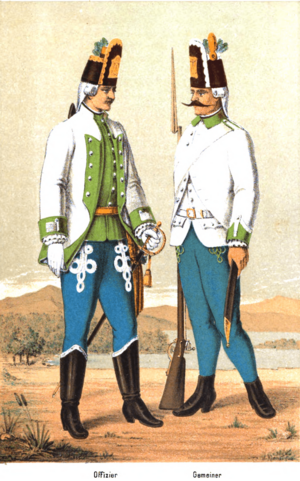Grenz infantry facts for kids
Quick facts for kids Grenz infantry |
|
|---|---|

Serbian Grenzer, 1742
|
|
| Country | |
| Type | Light infantry Border guard |
| Nickname(s) | Grenzers / Krajišnici |
| Engagements | Ottoman–Habsburg wars and the Napoleonic Wars |
| Commanders | |
| Notable commanders |
Adam Bajalics von Bajahaza, Wilhelm von Wartensleben, Ignác Gyulay, Mathias Rukavina von Boynograd, Josef Philipp Vukassovich |
The Grenz infantry, also known as Grenzers or Granichary, were special soldiers from the Military Frontier in the Habsburg monarchy. This area was a border zone between Christian Europe and the Ottoman Empire. The word "Grenzer" comes from German and means "border guard" or "frontiersman".
These soldiers were originally formed to protect their homes from the Ottoman Turks. When there was no war with the Ottomans, the Grenzer regiments were sent to fight in other wars for the Habsburgs. However, one group from each regiment always stayed behind to guard the border. Some Grenzers, called Granichary, were even invited to Imperial Russia. They formed a historic border region in modern Ukraine called New Serbia.
Who Were the Grenzers?
The Grenzers were like a new version of earlier irregular troops called Pandurs. These Pandurs were also a special army group created by the Habsburgs in the 1700s. They defended the border and fought as skirmishers in wars like the Seven Years' War.
By the time of the Napoleonic Wars, Grenzers became more like regular soldiers. But Austrian generals still saw them as a mix between light and regular soldiers. They were very good at shooting and fighting in small groups. They also learned basic battle formations. At the start of the Napoleonic Wars, the 18 Grenzer regiments made up about a quarter of the entire Habsburg army.
Grenzers were best at skirmishing, which means fighting in small, spread-out groups. Some Austrian commanders did not think they were as good as regular soldiers for fighting in straight lines. After a small rebellion in 1800, their numbers were greatly reduced.
Despite this, the Grenzers fought very well in battles. They earned respect from the French army, especially at the Battle of Marengo and the Battle of Austerlitz. Even Napoleon thought highly of them. He called them the most warlike troops in the whole Austrian army. After Austria lost the War of the Fifth Coalition in 1809, Napoleon used Grenzer soldiers himself. The Treaty of Schönbrunn forced Austria to give up some border lands. This meant six Grenzer regiments (the 1st, 2nd, 3rd, 4th, 10th, and 11th) joined the French army. They fought for Napoleon until he was defeated in 1814.
During the 1800s, the threat from the Ottoman Turks became much smaller. This meant fewer soldiers were needed to guard the border. Also, people in the region started to want their own independent nations. The Austrian high command became worried about the Grenzers possibly rebelling. Because of these reasons, the number of Grenzer soldiers slowly went down. However, they continued to serve in the Austrian and later Austro-Hungarian army until World War I.
Where They Fought
Grenzers defended the state border from the Ottomans in areas like Croatia, Slavonia, and Hungary, including Transylvania. In Croatia and Slavonia, the Grenzer soldiers were Croats, Serbs, Vlachs, Uskoks, and Martolos. In Hungary, they were Croats, Serbs, Hajduks, Martolos, and Vlachs.
Some groups, like the Vlachs in Croatia and the Hajduks in Hungary, had special rights and privileges. The Vlachs brought their own traditional laws from the Balkans. The Hajduks in Hungary were a special social group.
Grenzer Regiments
Here are some of the main Grenzer regiments and their home bases:
- 1. Liccaner / Gospić
- 2. Otocaner / Otočac
- 3. Oguliner / Ogulin
- 4. Szluiner / Karlovac
- 5. Warasdiner-Kreuzer / Bjelovar
- 6. Warasdiner-St. Georger / Bjelovar
- 7. Brooder / Vinkovci
- 8. Gradiscaner / Nova Gradiška
- 9. Peterwardiner / Mitrovitz
- 10. First Banal / Glina
- 11. Second Banal / Petrinja
- 12. Deutschbanater / Pancsova
- 13. Wallachian-Illyrian / Karánsebes
- 14. First Szekler / Csík-Szereda
- 15. Second Szekler / Kézdi-Vásárhely
- 16. First Wallachian / Orlát
- 17. Second Wallachian / Naszód
See also
- Hussar
- Pandurs
- Skirmisher



